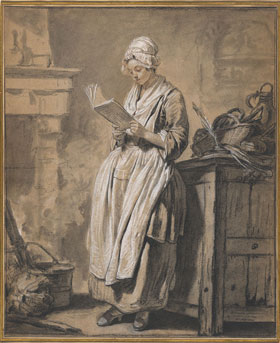10.7.24 — A Taste for Collecting
Say what you will about the Elizabeth and Jean-Marie Eveillard collection at the Morgan Library: the collectors have taste.
No doubt they must if they are to go about their self-appointed task, but they have good taste in museums, too. They had the taste to contribute to the Frick Collection, which displayed their gift just last year. Now they continue as donors to another of New York’s most treasured enclaves. The gift brings just over two dozen drawings to the Morgan, from the Baroque through early Modernism, through October 6, just in time for the Moore gift to the Morgan (and my apologies if you just missed it)— and I bring my reports of both together as a longer review and my latest upload. If it is a touch tasteful, you will understand. Just do not mistake a welcome plainness and discipline for good taste.
and I bring my reports of both together as a longer review and my latest upload. If it is a touch tasteful, you will understand. Just do not mistake a welcome plainness and discipline for good taste.
Those who caught the Eveillard gift at the Frick will know it all but exclusively for decorative art. That suited an institution in its temporary quarters on Madison Avenue, with separate rooms for decorative art. What, then, should one expect for J. P. Morgan’s domain as himself a collector? Would the drawings run once more to excess or rather to another side of the decorative arts—academicism in place of experiment. In the end, sobriety wins out, and it need not be all that tasteful. It illuminates how much study goes into seemingly wilder art.
Peter Paul Rubens brings his usual sweeping gestures and creative excess to a biblical scene, with alternative compositions that collide on a single sheet on their way into the sky. Something of his musculature and movement appears as well in John the Baptist by a lesser artist, Tanzio da Varallo, around 1620. What, then, should one make of a seated woman in a sober dress by Juan Gris, without a trace of Cubist fragmentation? Tired of the repetition and contortions in sculpture by Auguste Rodin? Here a female nude lies asleep. The composition follows that of a standing nude regardless, with her head above her feet, and a second pair of legs show the artist finding his way and bringing her awake.
Artists, then, had work to do on their way to paintings and prints. Some never get all that far, and the show has its share of minor names and failures. Rembrandt focuses on an emotionally and morally laden moment, Judas returning the thirty pieces of silver, but it is less than memorable. Others, though, revel in restraint. Antoine Watteau often does, while inventing Rococo lightness, but what of Romanticism and Théodore Géricault? Soon after The Raft of the Medusa, with its the heroics on the verge of death, he sketched ordinary workers unloading a cart.
As with Géricault, plain and simple may be in service of sympathy with those that art might easily have left out. Paul Signac poses his grandfather, mother, and maid for The Dining Rome. Eugène Delacroix tones down the action for his caretaker, Guercino for a Moor. Paul Gauguin abandons his mythic women for a Tahitian child. Jean-Baptiste Greuze dispenses for once with his moralism for a cook reading. The engraver who received the drawing called her a thief, but she looks absorbed in her work and her imagination.
More often still, the artists worked from studies because that is what they do. John Constable takes care for layers of landscape, but Pierre-Auguste Renoir in watercolor can linger on a handful of clouds or trees, too. Jacob Jordaens in the Baroque and Georges Seurat in Post-Impressionism alike show standing figures from behind, in full weight. Those who know his drawings will know how much his art depends on the discipline of Conte crayon in black and white. For Edgar Degas, every painting is akin to a study, here with wild horses rather than dancers. For Paul Cézanne, the interplay of experiment and experience is the essence of art.
There have been better drawings and more ambitious exhibitions. The Eveillard gift to the Frick already had me thinking of how much finer it will look integrated into the Frick mansion as context for art. Still, it gets at space between experiment and experience. A dreamer by Odilon Redon from 1898 surrenders herself to her dream, but she seems so still, and she could be looking inward or observing the sky. A swash of white could be an emblem of surrender, a bird, or a cloud. She is of a piece with the readers and observers in work to every side.
Read more, now in a feature-length article on this site.